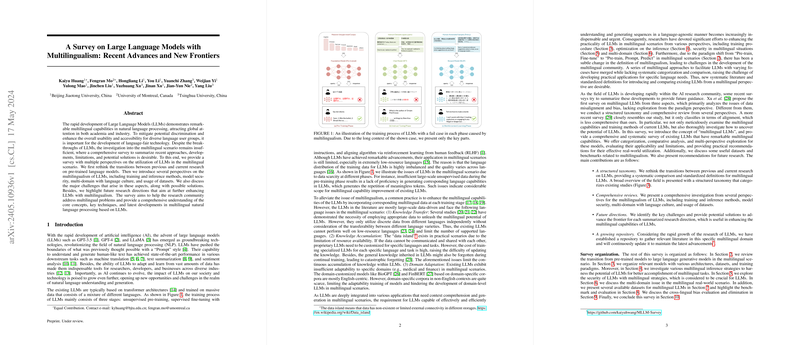Understanding Multilingual Capabilities in LLMs
LLMs like GPT-3, GPT-4, and LLaMA have transformed NLP in ways we could not have imagined a few years ago. Yet, despite their profound impact, there’s a significant gap when it comes to these models’ performance across different languages. A recent comprehensive survey aims to tackle this issue by exploring the multilingual capabilities of LLMs from various perspectives, such as training paradigms, inference strategies, security, and multi-domain applications.
Training Paradigms
From Scratch
Training LLMs from scratch with multilingual data involves incorporating diverse languages from the outset. A notable example here is XLM, which uses Translation LLMing (TLM) to enhance cross-lingual capabilities. Similarly, PolyLM employs curriculum learning to balance language data during pre-training. However, this approach underscores a crucial challenge: obtaining vast, high-quality multilingual datasets, especially for low-resource languages.
Continual Training
An efficient alternative to training from scratch is continual training on top of foundational models with new multilingual data. This method leverages existing knowledge while updating the model with additional language data. For instance, the BigTrans and Chinese-LLaMA models build on pre-trained models, improving their multilingual abilities without incurring the enormous costs of retraining. Nevertheless, this approach must solve catastrophic forgetting – where new knowledge interferes with old information – and deal with data scarcity in low-resource language settings.
Inference Strategies
Direct Inference
Direct inference, where models process text natively in multiple languages, is becoming more viable with advances in LLMs. Models like GPT-4 and PaLM-2 show promising results. Direct inference preserves linguistic nuances and ensures efficient processing by eliminating the translation step, but performance can still suffer in low-resource languages.
Pre-Translation
Pre-translation approaches convert input text into a high-resource language, like English, before processing. While this may allow models to leverage their strongest language proficiency, it introduces dependencies on high-quality translation tools and potential errors, which can distort meaning.
Multilingual CoT
Chain of Thought (CoT) strategies, initially successful in monolingual settings, are adapted for multilingual contexts. This involves instructions either in native languages or in English (e.g., "Let's think step by step"). The effectiveness varied, showing better results when instructional language is English.
Retrieval Augmented Generation (RAG)
RAG enhances LLMs by integrating external knowledge during text generation. This approach shows significant promise, especially for low-resource languages where models show a predisposition towards hallucinations or factual inaccuracies.
Code-Switching
Handling code-switching in multilingual dialogue settings, where speakers switch between languages, remains challenging for LLMs. Recent work shows that even powerful models struggle without tailored fine-tuning.
Security
Attack Methods
LLMs are vulnerable to various attacks, including jailbreaks, which trick them into bypassing safety protocols. Prompt-based methods, gradient-based methods like Greedy Coordinate Gradient (GCG), and multilingual-specific attacks expose these vulnerabilities. Certain languages, particularly low-resource ones, often bypass strict safety checks due to less extensive fine-tuning in those languages.
Defense Methods
Defense strategies range from enhanced training protocols to real-time input analyses, but there is no foolproof method yet. Methods like SmoothLLM show promise in perturbing input prompts to avoid generating unsafe outputs.
Multi-Domain Applications
In specialized fields like medicine and law, building effective multilingual models includes challenges that go beyond common LLM tasks. Models like MMedLM2 and BioMistral adapt LLMs to medical contexts across multiple languages, showing significant improvement within their domains. However, acquiring high-quality multilingual data remains a big hurdle, exacerbated by cultural and contextual intricacies unique to each language.
Data Resources and Benchmarking
The scarcity of large, high-quality multilingual datasets is a significant bottleneck. Datasets like MultiLegalPile and XMedBench offer initial steps towards bridging this gap. Comprehensive benchmarks that account for cultural and contextual factors across languages need to be developed to accurately reflect LLM performance in multilingual environments.
Bias and Fairness
Addressing biases in multilingual LLMs involves understanding both language-specific and demographic biases. While incremental improvements are made through techniques like up-sampling and adversarial training, the field still lacks robust tools and datasets to fully mitigate these biases.
Conclusion
Despite the impressive strides made in multilingual capabilities of LLMs, much work remains. Researchers must continue exploring advanced training strategies and inference methods while developing robust evaluation benchmarks and addressing biases to truly achieve language-fair AI. For both academia and industry, fostering collaboration and sharing resources will be crucial in overcoming these challenges and unlocking the full potential of LLMs in multilingual contexts.
